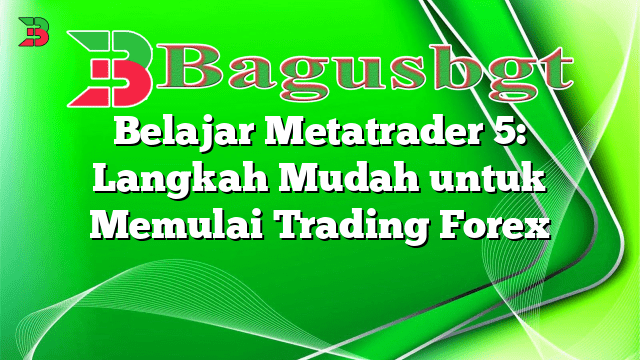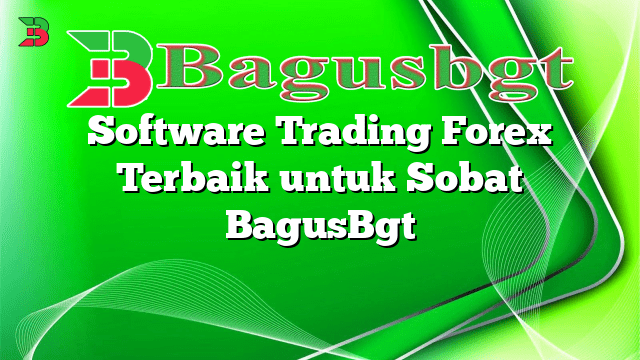Hello, dear readers! In this article, we will delve into the world of forex trading and explore the basic terms that every aspiring trader should be familiar with. Forex trading, also known as foreign exchange trading, involves the buying and selling of currencies on the foreign exchange market. It is one of the largest and most liquid financial markets in the world, offering immense opportunities for profit. So, let’s dive in and expand our knowledge on the basic terms in forex trading.
1. Currency Pair
A currency pair is the quotation of two different currencies, with the value of one currency being expressed in terms of the other. For example, EUR/USD represents the euro against the US dollar. Understanding currency pairs is essential as they are the building blocks of forex trading.
Advantages:
– Currency pairs provide opportunities for traders to profit from fluctuations in exchange rates.- They allow diversification of trading strategies, offering a wide range of options.- Forex trading with currency pairs enables traders to take advantage of global economic trends.
Disadvantages:
– Currency pairs can be highly volatile, leading to increased risk.- The complexity of analyzing multiple currency pairs requires a deep understanding of global economics.- Fluctuations in exchange rates can result in potential losses if not managed properly.
2. Pip
A pip, short for “percentage in point,” is the smallest unit of measurement in forex trading. It represents the change in the exchange rate of a currency pair. Most currency pairs are quoted to the fourth decimal place, with a pip typically equal to 0.0001.
Advantages:
– Pips help traders calculate potential profits or losses accurately.- They provide a standardized measurement for analyzing market movements.- Understanding pips allows traders to set precise entry and exit points.
Disadvantages:
– Small changes in pips may not always result in significant profit or loss.- Some currency pairs are quoted to the fifth or third decimal place, making calculations more complex.- Overemphasis on pips can lead to neglecting other crucial aspects of trading, such as risk management.
3. Bid and Ask Price
The bid price refers to the price at which traders can sell a currency pair, while the ask price is the price at which traders can buy a currency pair. The bid price is always lower than the ask price, creating a bid-ask spread, which represents the transaction cost.
Advantages:
– Bid and ask prices provide transparency in the forex market.- Traders can execute trades at their preferred prices by placing limit orders.- Understanding the bid-ask spread helps traders assess market liquidity.
Disadvantages:
– The bid-ask spread can vary across different brokers, potentially affecting trading costs.- Market volatility can widen the spread, making it more challenging to enter or exit positions.- Rapid fluctuations in bid and ask prices can result in slippage, causing trades to be executed at different prices than expected.
4. Leverage
Leverage allows traders to control larger positions in the market with a smaller amount of capital. It is expressed as a ratio, such as 1:100 or 1:500. For example, with a 1:100 leverage, a trader can control $100,000 worth of currency with just $1,000 in their trading account.
Advantages:
– Leverage amplifies potential profits, enabling traders to make significant gains with a smaller investment.- It provides accessibility to the forex market for traders with limited capital.- Leverage allows traders to diversify their trading strategies and take advantage of various opportunities.
Disadvantages:
– High leverage increases the risk of losses, as even small market movements can lead to significant losses.- Inexperienced traders may misuse leverage, leading to substantial financial losses.- The use of leverage requires strict risk management to avoid excessive exposure to the market.
5. Margin Call
A margin call is a notification from the broker to the trader, indicating that their account’s equity has fallen below the required margin level. It typically occurs when a trader’s losses on open positions deplete the available margin in their account.
Advantages:
– Margin calls act as a safety mechanism to protect traders from incurring more significant losses than their account balance.- They prompt traders to reassess their positions and adjust their trading strategies accordingly.- Margin calls help maintain market stability by preventing excessive risk-taking.
Disadvantages:
– Margin calls can lead to the automatic closure of open positions, potentially resulting in realized losses.- Emotional stress and panic can arise when receiving a margin call, affecting traders’ decision-making abilities.- Frequent margin calls may indicate a lack of risk management and trading discipline.
6. Stop-Loss Order
A stop-loss order is a risk management tool that allows traders to set a predetermined exit point for a trade. It automatically closes the position if the market moves against the trader beyond a specified level, limiting potential losses.
Advantages:
– Stop-loss orders protect traders from significant losses by enforcing disciplined risk management.- They provide peace of mind by reducing the need for constant monitoring of open positions.- Stop-loss orders allow traders to automate their trading strategies and remove emotional biases.
Disadvantages:
– Stop-loss orders can be triggered by short-term market fluctuations before the trade has a chance to move in the desired direction.- Placing stop-loss orders too close to the entry point may result in premature position closures.- Overreliance on stop-loss orders without considering market volatility and price fluctuations can lead to frequent stop-outs.
7. Take-Profit Order
A take-profit order is the opposite of a stop-loss order. It allows traders to set a predetermined target price at which their position will be automatically closed, locking in profits.
Advantages:
– Take-profit orders help traders secure profits by automatically closing positions at favorable levels.- They remove emotional biases by enforcing disciplined profit-taking.- Take-profit orders allow traders to balance their risk-reward ratios and maintain a disciplined trading approach.
Disadvantages:
– Setting take-profit orders too close to the entry point may result in premature position closures, preventing further potential gains.- Market volatility and price fluctuations can make it challenging to determine the optimal take-profit level.- Overly ambitious take-profit targets may lead to missed opportunities as positions close before reaching their full profit potential.
8. Spread
The spread refers to the difference between the bid and ask prices of a currency pair. It represents the transaction cost incurred by traders when entering or exiting a trade. Brokers typically earn their profits from the spread.
Advantages:
– Traders can assess the cost-effectiveness of their trades by considering the spread.- Tight spreads enhance trading profitability, especially for short-term traders.- Understanding spreads helps traders choose brokers offering competitive pricing.
Disadvantages:
– Wide spreads can erode potential profits, particularly for frequent traders.- Some brokers may manipulate spreads during periods of high market volatility.- The spread can vary across different currency pairs, requiring traders to consider the cost implications while selecting their trading instruments.
9. Liquidity
Liquidity refers to the ease with which a currency pair can be bought or sold without causing significant price changes. Highly liquid currency pairs have a large number of buyers and sellers, ensuring efficient trade execution.
Advantages:
– High liquidity provides traders with instant execution and minimal slippage.- It allows traders to enter and exit positions at their preferred prices.- Liquidity ensures that traders can actively participate in the market without limitations.
Disadvantages:
– Low liquidity in certain currency pairs can result in wider spreads and higher transaction costs.- Illiquid markets are prone to price manipulation, potentially exposing traders to unfair practices.- Traders must be cautious when trading illiquid currency pairs as it may be challenging to exit positions at desired prices.
10. Candlestick Chart
A candlestick chart is a popular type of price chart used in forex trading. It provides visual representation of price movements over a specific period. Each candlestick consists of a body and wicks, indicating the opening, closing, high, and low prices within the given time frame.
Advantages:
– Candlestick charts offer valuable insights into market sentiment and price trends.- They provide a visual representation of support and resistance levels.- Traders can identify patterns and make informed trading decisions based on candlestick formations.
Disadvantages:
– Misinterpretation of candlestick patterns can lead to incorrect trading decisions.- Candlestick analysis requires experience and knowledge to effectively predict market movements.- Sole reliance on candlestick charts without considering other technical indicators may result in incomplete trading strategies.
The quotation of two different currencies, showing the value of one currency in terms of the other.| Term | Definition |
|---|---|
| Currency Pair | |
| Pip | The smallest unit of measurement in forex trading, representing the change in the exchange rate of a currency pair. |
| Bid and Ask Price | The bid price is the price at which traders can sell a currency pair, while the ask price is the price at which traders can buy a currency pair. |
| Leverage | A ratio that allows traders to control larger positions in the market with a smaller amount of capital. |
| Margin Call | A notification from the broker to the trader indicating that their account’s equity has fallen below the required margin level. |
| Stop-Loss Order | A risk management tool that allows traders to set a predetermined exit point for a trade. |
| Take-Profit Order | A predetermined target price at which a trader’s position will be automatically closed, locking in profits. |
| Spread | The difference between the bid and ask prices of a currency pair, representing the transaction cost incurred by traders. |
| Liquidity | The ease with which a currency pair can be bought or sold without causing significant price changes. |
| Candlestick Chart | A type of price chart that visually represents price movements over a specific period using candlestick formations. |
Frequently Asked Questions (FAQ)
Q: Can I trade forex without leverage?
A: Yes, you can trade forex without leverage. However, leverage allows you to control larger positions and potentially amplify your profits. It is important to consider your risk tolerance and use leverage responsibly.
Q: How do I determine the optimal stop-loss and take-profit levels?
A: Determining stop-loss and take-profit levels involves considering various factors such as market volatility, support and resistance levels, and your trading strategy. Technical analysis tools and indicators can assist in identifying potential levels.
Q: What is the best time frame to use for candlestick analysis?
A: The best time frame for candlestick analysis depends on your trading style and objectives. Short-term traders may use smaller time frames like 1-hour or 15-minute charts, while long-term traders may focus on daily or weekly charts.
Conclusion
In conclusion, understanding the basic terms in forex trading is crucial for aspiring traders. Currency pairs, pips, bid and ask prices, leverage, margin calls, stop-loss and take-profit orders, spreads, liquidity, and candlestick charts play vital roles in the forex market. While each term offers advantages, it is important to recognize their potential drawbacks and use them in conjunction with a well-defined trading strategy. By mastering these basic terms and continuously expanding your knowledge, you will be better equipped to navigate the exciting world of forex trading.
 Bagus Banget Kumpulan Informasi terbaru dari berbagai sumber yang terpercaya
Bagus Banget Kumpulan Informasi terbaru dari berbagai sumber yang terpercaya


